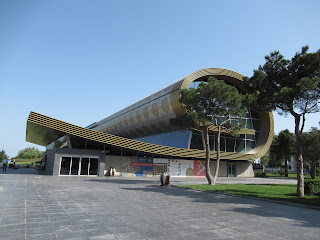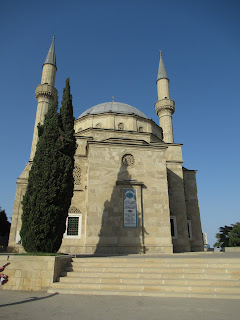Reading this post via email or mobile
version? Want to read comments or enter your own? Want to see posts from other
years or even previous posts from this year? Just click on the post title to
access our full web page.
The building of the creatively designed Carpet Museum had the shape of a rolled carpet! UNESCO listed the traditional art of Azerbaijan carpet weaving as "an intangible, cultural heritage of humanity."
The building of the creatively designed Carpet Museum had the shape of a rolled carpet! UNESCO listed the traditional art of Azerbaijan carpet weaving as "an intangible, cultural heritage of humanity."
The Museum had an unusual policy of allowing photos to be taken with a phone but not with a camera for some reason! Steven and I love what we have generally called 'Oriental' handmade carpets and were curious to see a museum wholly devoted to them. Neither of us had been aware before of Azerbaijan's rich carpet-making tradition. Seeing this breathtaking display of such beautiful works of art took our breath away.
Wattled mats, made from reeds and cane, were widely used in the households of mountain people and by inhabitants in the lowlands. In the past, plain mats were used as covers for tents and decorated mats were used as partitions and for interior decoration.
Khasir mats, made from the fibers of different trees, straw, reeds, etc, were mainly used in the subtropics of southern Azerbaijan for floor and moisture protection.
I learned that Palas, one of the most common types of flat woven carpets, were made of wool, cotton, silk, flax or hemp. Some palas have intricate geometric designs depending on the town where they are made. Palas were used for floor coverings, curtains, saddlebags, seat cushions, bags, etc.
This handwoven, wool Zili carpet was made in the 19th century.
Just imagine these stunning works of art being used as saddlebags. We just finished a three day horse trek here in neighboring Kyrgyzstan and I can assure you our saddlebags were nothing like these!
I watched a brief video showing how woven, carpet-like pieces were used to cover temporary dwellings akin to a yurt.
For people of Azerbaijan, carpets "are a best friend accompanying a person throughout his entire life from the moment of birth, at all important events such as weddings and holidays, and during the most bitter days, until the very last moment. Not only the carpet itself is considered sacred, but also some elements of its development and manufacture. Thus, according to the legend, the spindle is the earth's axis, the spinner weaves her feminine destiny, loops and nodes applied to the surface of the carpet signify strong ties, permanence and eternity, and various carpets have magic powers and properties of a talisman."
The famous 17th century Khatai or Dragon carpet was one of the rarest and most remarkable in the museum's collection and was just donated to the museum this year. The dragon motif used by the Turkic people is one of the oldest images that adorn many of Azerbaijan's art monuments and is part of Azeri folktales.
I chatted for a while with two teenagers who spoke perfect English from Karachi, Pakistan, while we each took turns walking and taking pictures of each other on the glass atop a gorgeous carpet. I knew intellectually of course the glass would support me but taking that first step onto the glass was scary!
The portrait was of Latif Kerimov who taught carpet weaving art. He was quoted as advising people to "love carpets. Carpets will never leave you, never betray you. Carpets will always support, protect, help and please you." Having read Kerimov's philosophy on carpets, I don't think I will ever view our Oriental rugs the same way again!
Kerimov sketched these incredibly intricate carpet designs on paper before they were then created! I thought the sketches or really paintings themselves were beautiful works of art.
The Tree of Life is one of the most ancient religious symbols in the country's art and dated back to black, glazed ceramics in the Bronze Age and people worshiping trees in the 7th century. Even today, there are 'sacred trees' in many rural parts of Azerbaijan and the belief in their charm-like powers is firmly set in the minds of its people.
The motif has a vast number of varieties in the art of carpet weaving in Azerbaijan. Very often, pairs of animals, birds or people are depicted on the sides of the very stylized motif of the tree of life. The tree of life thus acquires a deeper meaning and turns into a model of the universe.
From the exquisite to the bizarre: everything in this 'room' was made from carpets! Talk about thinking outside the box, huh!
Being more of a traditionalist when it comes to carpets, I wasn't wild about some of the newer carpet designs although I appreciated the inclusion of the importance of the country's oil industry in the design of this one that looked like an oil spill.
We have been to hundreds of museums all over the world but visiting the Carpet Museum in Baku was a very special treat as it was so different from the usual history or art museums we know about and visit on our travels.
Both Steven and I thought this was about the prettiest underpass we've ever seen as normally they are places you want to hurry through as quickly as possible because of the unwelcome smells and often unsavory people who appear to be staying for long periods and not just passing through!
Since arriving in Baku the previous afternoon, we had spotted the iconic Flame Towers from so many vantage points and were determined to see them up close. The easiest and most enjoyable way was to take a funicular up the ridge.
I am sure the trio of sinuous blue glass skyscrapers must be a fabulous sight at night when a light show on each changes from a fire effect, to pouring water to the country's national flag but we thought it was still pretty spectacular in the late afternoon.
By the Towers was the Turkish Mosque that had been a gift from that country in 1996. The mosque was recently reopened after being closed for political reasons.
Men entered the mosque in the rear through the large middle doors while women gained access from the small doorway on the left. Women then had to climb upstairs to pray, or, in my case, to take pictures from behind a curtain!
Since there were no other women upstairs, I don't think anyone noticed my pulling the curtains open a bit so I could take these photos to share with you!
We have been in enough mosques in other countries to know that this structure is called the Minbar. The imam delivers the sermon at the Friday prayer from the minbar's raised steps.
We had a lovely view of the city from behind the mosque.
Another reason we'd wanted to explore the Flame Towers area was to visit Sahidlar Xiyabani, a park that had a somber row of grave memorials of victims of the Red Army's January 1, 1990 attack on Baku.
Unlike most Western cemeteries, virtually all the headstones had photos of the deceased so it created a greater sense of identification and made a more personal with those who had died. Most of the young men had died within just days of each other after the attack.
How tragic to see mostly men in their early 20s memorialized along Martyrs' Alley who gave their lives for defending their lives fighting Russian aggression.
The memorial was to Turkish WW I soldiers and, more controversially, to the British and Commonwealth troops killed fighting them. Visiting heads of state are normally brought here to pay their respects soon after arriving in Baku.
From the memorial we had our best view yet of the fabulous Flame Tower buildings that ranged from 28 to 33 stories.
Still being built along the stunning waterfront was a potentially phenomenal architectural attention-grabber in the shape of an upside down crescent moon! At the other end of the bay was a half-built spherical 'sun' building commonly nicknamed the Death Star Hotel! When they are both completed, they will further add to Baku's stunning architectural legacy.
Next post: A day trip discovering mud volcanoes, petroglyphs and Azerbaijan's rich oil history.
Posted on September 17th, 2018, from Karakol, Kyrgyzstan.

























































What a fascinating carpet museum! I find it hard to walk on my Turkish carpet, its so pretty. So, it is hanging on the wall. Lil Red
ReplyDeleteLilRed, I can see now that's not an unusual practice since visiting the one of a kind Carpet Museum in Baku! Steven and I bought a rug we fell in love with in Cappadoccia, Turkey, a few years ago but we put it on the floor in the study, never thinking of another option. Also, we'd never have room for it on the walls with all the pictures and wall hangings from our adventures! Will already have to shuffle some things around to make room for a stunning Kyrgyz silk hanging from the 1930s we bought in Kochkor. Annie
ReplyDeleteThe architectural landmarks you chose to highlight are unique and eye popping -- the carpet museum shaped as a carpet, the flame towers, the memorials etc... thanks for the tour ! xo
ReplyDeleteI'm more ignorant of the world than I ever imagined. I've heard of Baku but never imagined or thought that it would be so beautiful. It doesn't seem to be a significant tourist destination for us westerners. Thanks for shedding some light on the locale for us.
ReplyDeletePaul, We were also delighted with how beautiful we found Baku to be - definitely an unsung treasure in my mind, especially the Heydar Aliyev Cultural Center which should be on everybody's short list for anyone interested in architecture.
ReplyDeleteI think it is becoming a major destination for Western Europeans and people from other countries if NOT for North Americans, Paul - a big difference when you talk about Westerners in my mind.